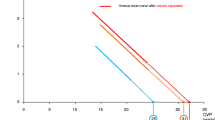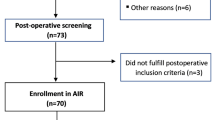Abstract
Objective
To describe the evolution of systemic and regional blood flows during and after hypovolemia in humans.
Design
Simulation of hypovolemia by a prolonged application of lower body negative pressure (LBNP).
Setting
Laboratory of Clinical Research, Surgical Intensive Care Unit of an University Hospital.
Participants
8 healthy male volunteers.
Interventions
3 successive and increasing 15min-levels of LBNP were followed by a progressive return (10 min) to atmospheric pressure, then a 60min-recovery period.
Measurements and main results
Simulated hypovolemia induced a parallel one-third decrease in cardiac output (bioimpedance), musculocutaneous (venous plethysmography) and splanchnic (ICG clearance) blood flows. Adrenergic-mediated peripheral vasoconstriction prevented any change in mean arterial pressure. The decrease in renal blood flow (PAH clearance) was limited, glomerular filtration rate (inulin clearance) unchanged and thus filtration fraction increased. All the cardiovascular and biological variables returned to pre-LBNP values during the recovery period except for splanchnic blood flow which remained below control values 60 min after the return to atmospheric pressure.
Conclusions
Since a sustained splanchnic vasoconstriction follows a transient normotensive hypovolemia in healthy men despite adequate treatment considering arterial pressure and cardiac output, the therapeutic goals of fluid resuscitation after hypovolemic shock might be revisited and a supranormal value of cardiac output proposed.
Similar content being viewed by others
References
Faist E, Baue AE, Dittmer H et al. (1983) Multiple organ failure in polytrauma patients. J Trauma 23:775–787
Wang P, Hauptman JG, Chaudry IH (1990) Hemorrhage produces depression in microvascular blood flow which persists despite fluid resuscitation. Circ Shock 32:307–318
Maningas PA (1987) Resuscitation with 7.5% NaCl in 6% dextran 70 during hemorrhagic shock in swine: effects on organ blood flow. Crit Care Med 15:1121–1126
Vedder NB, Winn RK, Rice CL, Chi EY, Arfors KE, Harlan JM (1988) A monoclonal antibody to the adherence: promoting leukocyte glycoprotein CD18 reduces organ injury and improves survival from hemorrhagic shock and resuscitation in rabbits. J Clin Invest 81:939–943
Wang P, Hauptman JG, Chaudry IH (1990) Hepatocellular dysfunction occurs early after hemorrhage and persists despite fluid resuscitation. J Surg Res 48:464–470
Flynn WJ, Gryer HG, Garrison RN (1991) Pentoxyfilline but not saralazin restores hepatic blood flow after resuscitation from hemorrhagic shock. J Surg Res 50:616–621
Gottlieb ME, Sarfeh J, Stratton H, Goldman ML, Newell JC, Shah DM (1983) Hepatic perfusion and splanchnic oxygen consumption in patients postinjury. J Trauma 23:836–843
Hawker F (1991) Liver dysfunction in critical illness. Anaesth Intensive Care 19:165–181
Hirsch AT, Levenson DJ, Cutler SS, Dzau VJ, Creager M (1989) Regional vascular responses to prolonged lower body negative pressure in normal subjects. Am J Physiol 257:219–225
Duranteau J, Pussard E, Edouard A, Berdeaux A (1991) Lidocaine and cardiovascular reflex responses to simulated orthostatic stress in normal volunteers. J Cardiovasc Pharmacol 18:60–67
Scalia S, Burton H, Van Wylen D, Steinberg S, Hoffman A, Roche F, Flint L (1990) Persistent arteriolar constriction in microcirculation of the terminal ileum following moderate hemorrhage hypovolemia and volume restoration. J Trauma 30:713–718
Parati G, Casadei R, Gioppelli A, DiRienzo M, Mancia G (1989) Comparison of finger and intraarterial blood pressure monitoring at rest and during laboratory testing. Hypertension 13:647–655
Greenfield ADM, Whitney RJ, Mowbray J (1963) Methods for the investigation of peripheral blood flow. Br Med Bull 19:101–112
Wong DH, Tremper KV, Stemmer EA, O'Connor D, Wilbur S, Zaccari J, Reeves C, Weidoff P, Trujillo RJ (1990) Noninvasive cardiac output: simultaneous comparison of two different methods with thermodilution. Anesthesiology 72:784–792
Rowell LB (1974) Measurement of hepatic-splanchnic blood flow by the dye techniques. In: Bloomfield DA (ed) Dye curves; the theory and practice of indicator dilution. Baltimore, pp 209–229
Johnson JM, Rowell LB, Niederberger M, Elsman MM (1974) Human splanchnic and forearm vasoconstrictor responses to reductions of right atrial and aortic pressures. Circ Res 34:515–524
Cole BR, Giangiacomo J, Ingelfinger JR, Robson AM (1972) Measurement of renal function without urine collection. A critical evaluation of the constant-infusion technique for determination of inulin and para-hippurate. N Engl J Med 287:1109–1114
Causon RC, Carruthers ME, Rodnight R (1981) Assay of plasma catecholamines by liquid chromatography with electrochemical detection. Anal Biochem 116:223–226
Mark AL, Mancia G (1983) Cardiopulmonary baroreflexes in humans. In: Sheperd JT, Abboud FM (eds) Handbook of physiology, the cardiovascular system, vol III, sect 2. American Physiological Society, Bethesda, pp 795–813
Wolthuis RA, Bergman SA, Nicogossian AE (1974) Physiological effects of locally applied reduced pressure in man. Physiol Rev 54:1065–1069
Schadt JC, Ludbrook J (1991) Hemodynamic and neurohumoral responses to acute hypovolemia in conscious mammals. Am J Physiol 260:H305-H318
Bjurstedt H, Rosenhamer G, Tyden G (1977) Lower body negative pressure and effects of autonomic heart blockade on cardiovascular responses. Acta Physiol Scand 99:353–360
Rowell LB, Detry JMR, Blackman JR, Wyss C (1972) Importance of the splanchnic vascular bed in human blood pressure regulation. J Appl Physiol 32:213–220
Baily RG, Prophet SA, Sheuberger JS, Zelis R, Sinoway LI (1990) Direct neurohumoral evidence for isolated sympathetic nervous system activation to skeletal muslce in response to cardiopulmonary baroreceptor unloading. Circ Res 66:1720–1728
Samueloff SF, Browse NL, Shepherd JT (1966) Response of capacity vessels in human limbs to head-up tilt and suction on lower body. J Appl Physiol 21:45–54
Wilkins RW, Culbertson JW, Ingelfinger FJ (1951) Effects of splanchnic sympathectomy in hypertensive patients upon estimated hepatic blood flow in the upright position as contrasted with the horizontal position. J Clin Invest 30:312–317
Stadeager C, Hesse B, Henriksen O, Christensen NJ, Bonde-Petersen F, Mehlsen J, Giese J (1989) Effects of angiotensin blockade on the splanchnic circulation in normotensive humans. J Appl Physiol 67:786–791
Price HL, Deutsch S, Marshall BE, Stephen GW, Behar MG, Neufeld GR (1966) Hemodynamic and metabolic effects of hemorrhage in man, with particular reference to the splanchnic circulation. Circ Res 18:469–474
Rothe CF, Gaddis ML (1990) Autoregulation of cardiac output by passive elastic characteristics of the vascular capacitance system. Circulation 81:360–368
Myers BD, Deen WM, Brenner BM (1975) Effects of norepinephrine and angiotensin II on the determinants of glomerular ultrafiltration and proximal tubule reabsorption in the rat. Circ Res 37:101–110
Vatner SF (1974) Effects of hemorrhage on regional blood flow distribution in dogs and primates. J Clin Invest 54:225–235
Gilbert CA, Bricker LA, Springfield WT, Stevens PM, Warren BH (1966) Sodium and water excretion, and renal hemodynamics during lower body negative pressure. J Appl Physiol 21:1699–1704
Selkurt EE, Elpers MJ (1963) Influence of hemorrhagic shock on renal hemodynamics and osmolar clearance in the dog. Am J Physiol 205:147–152
Guttierez G, Palizas F, Doglio G et al. (1992) A controlled study of gastric intramucosal pH as a therapeutic index of tissue oxygenation in critically ill patients. Lancet 339:195–199
Hulten L, Lindhagen J, Lundgren O (1977) Sympathetic nervous control of intramural blood flow in the feline and human intestines. Gastroenterology 72:41–48
Lundgren O (1983) Role of the splanchnic resistance vessels in overall cardiovascular homeostasis. Fed Proc 42:1673–1677
Scherrer U, Vissing S, Morgan BJ, Hanson P, Victor RG (1990) Vasovagal syncope after infusion of a vasodilator in a heart-transplant recipient. N Engl J Med 322:602–604
Bulkley GB, Oshima A, Bailey RW (1986) Pathophysiology of hepatic ischemia in cardiogenic shock. Am J Surg 151:87–91
Bailey RW, Bulkley GB, Hamilton SR, Morris JB, Haglund UH (1987) Protection of the small intestine from nonocclusive mesenteric ischemic injury due to cardiogenic shock. Am J Surg 153:108–112
Caldini P, Permutt S, Waddel JA, Riley RL (1974) Effect of epinephrine on pressure, flow and volume relationship in the systemic circulation of dogs. Circ Res 34:602–623
Author information
Authors and Affiliations
Rights and permissions
About this article
Cite this article
Edouard, A.R., Degrémont, A.C., Duranteau, J. et al. Heterogeneous regional vascular responses to simulated transient hypovolemia in man. Intensive Care Med 20, 414–420 (1994). https://doi.org/10.1007/BF01710651
Received:
Accepted:
Issue Date:
DOI: https://doi.org/10.1007/BF01710651




